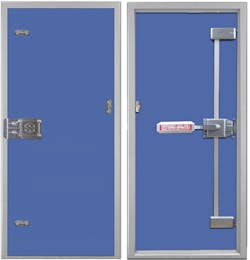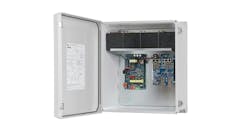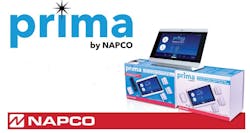Securitech’s Trident Multi-Point Exit Lock Helps Retailers Combat Theft
Merchandise losses (also referred to as shrinkage) cost retailers billions due to shoplifting, internal theft and other types of criminal activity every year. It is termed our nation’s “silent crime.”
Shoplifting is one of the most prevalent crimes in the United States, averaging about 550,000 incidents per day. Current estimates say as many as 1 in 11 Americans shoplift in our nation today and shoplifters are only caught 2 percent of the times they steal and then only turned over to police 50 percent of the time. The majority of shoplifters are non-professional, but 30 percent of them are compulsive or habitual thieves.
The shoplifting is primarily committed by otherwise law-abiding citizens enticed by the temptation and opportunity. More than 10 million people have been caught shoplifting in the last five years.
So there are many retailers confronted with the problem of their goods flying out the back door. Some shoplifters choose to grab and run through emergency exits. These losses are passed along to the rest of us by way of higher prices, restrictive security measures, increased taxes for police, and the cost to prosecute then incarcerate those convicted.
Another loss threat is through burglars. Burglars would rather wait until the store is closed. Although there is an element of opportunism present, it is quite different than the opportunity presented the shoplifter to quickly grab an item. Their opportunity is a back door that is perceived to be vulnerable to attack, and they are likely to be after more than one item. About 2.2 million burglaries occur each year.
The Securitech Trident™ is a locking solution designed to keep inventory in the store and keep burglars out of the store.
Securitech has long focused on niche markets which they perceived as problems that would evolve into trends. And indeed the trend has been more crime requiring better solutions.
The Trident is a multi-point lock system designed to be adaptable and configurable for a variety of applications.
Securitech has pioneered many such solutions using the adversarial streets of New York City as their proving ground. They were pioneers in multi-point locks, which are known to be far more effective at thwarting break–ins than single point locks. However when more than a single lock is mounted on a single door; unless the locks are part of an approved multi-point lock system, life safety violations are inevitable since the International Building Code (IBC 2009 – 1008.1.9) requires that a door be “readily openable from the egress side without the use of a key or special knowledge or effort.”
Several provisions of the National Fire Protection Act (NFPA) 101 – 2009 also apply. These include:
- 7.2.1.5.9. A latch or other fastening device on a door leaf shall be provided with a releasing device that has an obvious method of operation and that is readily operated under all lighting conditions.
- 7.2.1.5.9.1. The releasing mechanism for any latch, other than for existing installations, shall be located not less than 34 in. (865 mm), and not more than 48 in. (1220 mm), above the finished floor.
- 7.2.1.5.9.2. The releasing mechanism shall open the door leaf with not more than one releasing operation, unless otherwise specified in 7.2.1.5.9.3 and 7.2.1.5.9.4.
Improperly deployed multiple locks on a door represent not only building code violations but also hampers egress and endangers the customer and occupants of the premises controlled by the door. Security professionals must be mindful of both Life Safety (ensuring safe egress) and Security (protecting individuals and assets and keeping intruders and thieves out)
Since its introduction in 2005, the Trident system has evolved into a powerful solution both in terms of its ability to repel attacks and the features it offers the end-user. Trident also is designed with the local authority having jurisdiction (LAHJ) and code compliance in mind.
Q&A: Securitech’s Bill Nelson
Locksmith asked Securitech’s vice president of sales/marketing and Trident guru Bill Nelson a few questions to help us all understand the system better. Following are Ledger’s questions and Nelson’s answers.
Can you offer an overview of the Trident product?
What I can sum up is the Trident is the best exit lock out there. It has ease of installation with the template and has performed superbly in the field both operationally and against massive attacks. We are specified by major drug chains, high-end specialty retailers, electronics retailers, cell phone retailers, banking institutions, warehouses, military sites, restaurants and on many more exit doors.
An important feature which has contributed to the product’s success is we stopped putting ANY bolts into the floor as this was causing so much PAIN for installers and end users. Bolts into the floor are a nightmare to properly line up, drill and install. Many times there is a large gap under the door and then a thin aluminum saddle on the floor so security is compromised as that is all the bolt goes into.
Additionally dirt, dust, water, salt, ice, food (in restaurants when they wash the floor each night) etc. tend to jam the hole and prevent the lower bolt from being able to engage.
In their attempt to lock up at night end users would use excessive force on the paddle, trying to get the lower bolt into the floor and consequently break the lock. We have found locking into the frame as strong and far more reliable as locking into the floor.
Where is it primarily used?
Trident was designed to provide security where illegal slide bolts were typically mounted on the door – one above the exit device and one below -- very popular with back of house forced entry protection for retailers.
Trident’s installation method was a game changer. The full size steel template was designed to allow all holes to be drilled before removing the multi-point exit lock from the box. Trident is shipped with all moving parts attached – the first multi-point lock to do so.
Trident’s installation time of under 2 hours was another radical development in multi-point locking. Trident’s predecessor, the MP Panic Exit Police Lock shot bolts into the header and floor. Trident was designed in response to installer and user requests.
For anti-pry resistance, Trident has more thru-bolts than any other multi-point exit lock.
How many different models of the Trident are there? Is there a configuration matrix?
Basically there are two: Manual Re-Lock and Self Re-lock. The Trident was designed so you can choose the features you need and build a model easily. You start with a choice between manual or self re-lock. Then you choose between no alarm, just a signal when the paddle is pressed or wall-mounted alarm options (battery or direct power). The alarms “snap-in” to the exit lock and wiring skills are not required.
What would be the considerations for whether self-relocking or manual relocking is used? Is this field-configurable?
Self Re-Lock is used 80 percent of the time as folks don’t want doors left open. Manual Re-Lock is used on doors with a generally quick in and out, e.g. trip to close dumpster.
What is the difference between the models where the key permits momentary actuation of the lever or turnpiece and the models where the door can be unlocked and the lever turnpiece can be used for entry?
Mainly key operates lever for momentary opening but of course in Manual Re-Lock mode door can be push/pull. We also have a dogging feature for Self Re-Lock when they want it to be push/pull at certain times e.g. employee door where push/pull when guard is there but locked when they leave.
How does the electromagnetic lock option work? What are its features and benefits? Is it similar to or used with the electric release option?
Maglock version is when they want to use maglocks for traffic control during the day and lock the multiple Trident bolts after hours. They card in and push secondary RTE button on the paddle for exit. When all systems are locked, it is still one motion egress per code. This is very popular when the exit door is also an employee entrance or used repeatedly by employees grabbing a smoke.
What are the door strengthening bars?
Many times we are retrofitted in locations where the door is basic builders’ model with thin skins and no vertical stiffeners inside, just cardboard honeycomb. The bars strengthen the door against ramming or prying. Basically in that case it tries to bring the weaker element (the door) up to a higher standard so the lock can be more effective. As you know the door and frame are also critical elements.
When is the lower module reinforcement kit used?
When we see massive attack attacks occurring on lower grade doors, the lower module reinforcement kit is very effective. Almost all of the time the standard Trident holds up but sometimes we see the combination of low security doors and massive attacks occurring and we will recommend the upgrade kit. Preventing break-ins is a time game and the reinforcement kit adds time.
What is the Trident Alarm? What are its features and how is it installed?
Trident alarms are mounted on the wall, not the door. When the door is opened, the sound stays in the facility, not out into the parking lot. We have battery and hardwired units. Most order battery but especially in new construction with electrical trade on site, we get orders for hardwired. Some retailers choose battery for retrofit and hardwired for new construction. Most order with key capture where the bolts need to be thrown before key can be removed or alarm sounds. This makes sure the manager or another employee does not leave the alarm turned off when they are not there. You can also order with on/off feature. We can also do a door position switch so the customer knows the door is closed and bolts are locked. This signal would go to their access control system as a monitored point. The unit also has separate monitoring output option if needed for interfacing with other alarms (whether or not you use the Trident alarm), CCTV or other. There is an option for a remote or louder horn (e.g. large warehouses). Trident works with a standard mortise cylinder, so all major key and core systems. There are so many things we can do with our alarms that it would take me forever to list.
How is the Trident classified? Door alarm? Deadbolt? Exit device?
Standard it is an exit lock but we meet panic hardware requirements (generally for larger occupancies) when we extend the length of the paddle and also do a return where fire hoses cannot get caught. We even have California State Fire Marshal approval. With self locking, extended paddle, return and fire rated you have a fully compliant unit for use on fire doors in corridors and etc. If you order a self-locking exit lock unit, it can be upgraded to an exit device just by swapping out the paddle for the extended one.
What is the digital counter?
Every time the door opens and closes, it takes a count. This is like an odometer and cannot be altered. Many doors are emergency exit or low use only so when the customer sees entries on the counter that do no match usage requirement, then 9 times out of 10 something fishy is going on at that door e.g. theft or smokers sneaking outside violating company policy. The counter is used to keep the employees honest.
Explain how the delayed egress feature works and is deployed
Delayed egress was the last major feature added to the Trident system. Many retail stores want break-in protection and also need to prevent grab and runs. The Trident with delayed egress option (it can be ordered as full kit or retrofit kit) fills this need with a code compliant system. Hitting the paddle releases the Trident lock’s deadbolts and sounds an alarm and activates the timer in the delayed egress locking module. The module continues to hold the door closed for 15 seconds (30 where allowed by code). The alarm sound blows the thief’s cover and they cannot risk being discovered, so they typically drop the merchandise and exit a customer door as quickly as possible to avoid capture. The code compliant delayed egress timer unlocks the locking module after the 15- or 30-second period and the door provides free exiting. The alarm continues to sound and store personnel must manually reset the lock and alarm (as required by code).
The unit has the code required monitoring loop relay that ties in with the buildings life safety system for instant drop out of the delayed egress locking module if the Life Safety system is activated e.g. smoke head, pull station, sprinkler flow or other. We DO NOT use a maglock on our DE module so it can be used where local LAHJs forbid maglocks. The delayed egress system can be added to any existing Trident. An interface on the entry side allows for authorized shunting same as the interior. The power supply is included in the delayed egress kits.
Delayed egress code always requires connection to a fire alarm system and free exiting whenever the system is in fire alarm mode. Do you meet this requirement?
Yes. What is really, really special about our delayed egress system is that the locking module and controller can be added to ANY existing Trident system or purchased as part of a new Trident system. No other manufacturer has their delayed egress system as an add-on layer to their already installed product. This layered approach matches Securitech’s philosophy of letting you choose which type of alarm you want for your Trident (none, output signal only, battery or direct power) and exterior entry (none, keyed lever or electric release) and upgrading or changing components based upon current needs.
For more information, contact your local locksmith distributor or Securitech Group Inc., 54-60 46th St., Maspeth, NY 11378. Phone: 800-622-LOCK or 718-392-9000. Web: www.securitech.com.
Trident Multi-Point Exit Lock
MANUAL-LOCKING MODELS
TEL-100 Does Not Include Alarm
Add TEL-A10 for battery alarm
Add TEL-A20 for direct power alarm
Add TEL-SSO for existing alarms
TEL-110 Includes TEL-A10 battery alarm
TEL-120 Includes TEL-A20 direct power alarm
SELF-RELOCKING MODELS
TEL-200 Does Not Include Alarm
Add TEL-A10 for battery alarm
Add TEL-A20 for direct power alarm
Add TEL-SSO for existing alarms
TEL-210 Includes TEL-A10 battery alarm
TEL-220 Includes TEL-A20 direct power alarm
TEL-DEK Delayed egress kit to add to any Trident
ACCESSORIES
TEL-E12 Armored cable extension, 12", for doors 40"-48"
TEL-MC1 Mortise Cylinder, standard keyway, no special keying
TEL-RC1 Removable core mortise cylinder (Best Compatible, 2 operating keys, 1 change key)
TEL-RC2 Removable core rim cylinder (Best Compatible, 2 operating keys, 1 change key)
TEL-EP1 Extended paddle (when required)
TEL-EP2 Extended paddle with guarded return (when required)
Tim O'Leary
Tim O'Leary is a security consultant, trainer and technician who has also been writing articles on all areas of locksmithing & physical security for many years.






